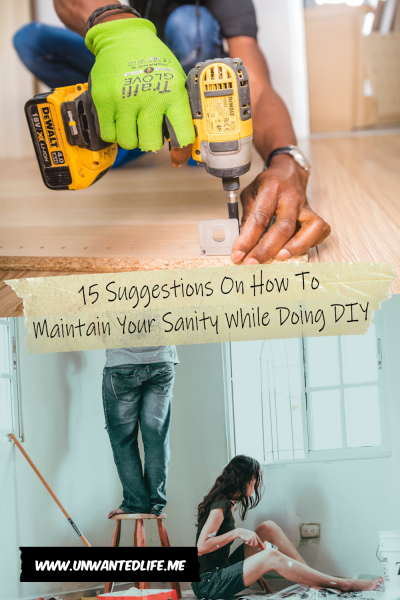I’ve been doing a lot of DIY lately, and much like my guide on how to have a stress-free move when moving home, I thought I’d do something similar for DIY. I hope you find this useful.
What Is DIY?
According to Kuznetsov and Paulos (2010, October), DIY, also known as Do It Yourself, is a practice that predates recorded history, because it was important to human survival. It’s not like you could call someone to come fix your broken spear while on the hunt for food. Even in the recent few hundred years, people have been fixing what’s broken, decorating, making clothes, etc. all without having to call in professionals. Today is no different. We still do that, and until robots do all the work for us, we’ll likely continue doing DIY for the foreseeable future.
The Benefits Of Doing DIY
During our run-in with COVID-19, a lot of people got into DIY as a way to make use of their time at home, and as a way to cope with what was going on during those unusual times. In fact, a study by Makhashvili et al. (2020) confirmed the benefits of DIY during COVID-19. Their study, which consisted of 2088 participant respondents with high levels of anxiety, depression, post-traumatic stress disorder (PTSD), and adjustment disorder, had a reduction in symptoms as a result of engaging in DIY. This helped them manage their concerns about COVID-19.
According to Wolf and McQuitty (2011), one of the reasons why DIY can be a valuable distraction for us is because it goes beyond just consuming something, like looking at a work of art or buying something. DIY requires us to invest mental and physical energy into it. We have to plan what we’re going to do, often look for advice, design what we plan to do, and then actually put all that together so we can finish the DIY project.
Buying a hammer, a saw, and other DIY tools have little to no meaning on their own, but once you use them in DIY, your DIY project develops meaning and purpose. And we all benefit from having meaning and purpose in our lives.
DIY, like anything that can spark our creativity, such as drawing or writing a novel, can bring our lives a sense of meaning that we don’t often get from our place of work. This is why DIY communities exist, so people can share their creative DIY talents and get inspired by other people’s DIY projects (Kuznetsov and Paulos, 2010, October).
There is nothing wrong with taking pride in your work, whether it be a painting, the shelves you put up, or the table you’ve made. This is what’s great about DIY. You get a sense of achievement through several different avenues, not just for completing a DIY task, but also because you might have done something you might not have thought you could do.
I know when two of my chest of drawers were beyond keeping, I managed to take the good parts from the two of them and put them together to create a fully working chest of drawers. I shared this achievement on Facebook at the time because I was proud that I was able to do that.
Since then, I’ve built a bed made out of scaffolding poles and reclaimed scaffolding boards, a table out of scaffolding and reclaimed pallet crates, and I’m currently doing a lot of DIY around where I live to make it a better living situation. For the latter, I’ve had to create a to-do list because there are so many different tasks my partner and I are working through, but crossing each item off also gives me that sense of achievement.
DIY Tips To Maintain Your Sanity
DIY projects can be a great way to save money and make your home more your own. However, it can also be stressful and overwhelming, especially if you’re not used to doing it. Here are a few tips to help you maintain your sanity while doing DIY:
Expectations
Set realistic expectations, because it’s going to be a difficult learning curve if you don’t have experience in the project you’re attempting. Also, don’t expect to complete a major DIY project overnight. Break it down into smaller, more manageable steps and give yourself plenty of time to finish. And I do mean plenty of time.
For example, to prepare to paint the walls, my partner and I had to use filler to fix cracks in the plaster, we had to sand everything, we had to wash everything with sugar water and then with regular water, all before we started painting. At first glance, that might seem like something you can do in a day or two, but it’s really not. A lot of the DIY tasks my partner and I have been doing over the last few months have taken a substantially longer time than it seemed it would.
Aim to overestimate how long it’ll take you, rather than underestimate and avoid rigid timelines that add pressure. No one needs that kind of stress when doing DIY.
Plan ahead
Before you start any DIY project, take some time to plan and gather all the necessary materials. This will help you avoid running into problems later on. It’ll also save you time, so you don’t have to keep running out to your local DIY store.
Shopping list
Create shopping lists as you work out everything you think you’ll need for the DIY task. I’ll save time by not having to keep returning to your local DIY store. It can also help with identifying which friends might have what you need.
Small steps
Break large projects into smaller steps, because it’ll help keep things manageable. Tackle your smaller steps one by one instead of getting overwhelmed by the big picture. This will also make it easier to plan.
For example, for painting the room, we sorted out tasks for each aspect of the preparation, because we had a lot to do before we could put paint on walls. This made it much easier to know what we were doing and then plan when we were doing each step.
Take breaks
DIY projects can be physically and mentally demanding. Don’t be afraid to take breaks throughout the day to rest and recharge. I’d even go so far as to have days off in between as well. Give your body time to heal, and your mind to rest. Your DIY project isn’t going anywhere, and if you’ve got a lot to do, a break can be a blessing so you don’t lose your motivation. My partner and I have taken several long breaks in between because we’ve just been doing so much DIY at the moment.
It might be better to work in manageable chunks of time, setting aside a few hours each day on a task rather than spending your entire weekend doing it. When I was filling in gaps between the floorboards with wood slivers, little and often was better, as shaving down the wood slivers was really demanding on my arms. So I just did an hour or two around my work hours, as I work from home.
Delegate tasks
If you have other people living in your home, don’t be afraid to ask for help with your DIY project. Even small tasks, like running to the store for supplies, can take a load off your mind. At the moment, I’m struggling with vertigo, which means there are some tasks I just can’t do without my vision and balance flipping upside down, so my partner was given the task of painting the ceiling and the edges between the ceiling and wall, while I did the bulk of the walls and skirting boards.
Read instructions
This is especially true if you’re new to DIY, but make sure you read the instructions thoroughly and watch whatever helpful videos to the end before starting. Don’t skip steps! Knowing what’s coming prevents surprises. It’ll also keep you safe and help avoid making mistakes.

Safety
Make safety a priority. Use proper protective gear and don’t operate tools when overly tired or rushed. We had to engage in a lot of sanding and tasks that put our eyes and lungs at risk. The amount of times splitters of wood hit my face while DIYing over the last few months really hammered home the importance of safety goggles. We also had to use respirators to protect us from all the dust from sawing and sanding. It doesn’t take much to develop a cough because of this, even with minor DIY work.
A cheap pair of safety gloves can also go a long way. I’ve already gone through three pairs. Throw in a face mask that is designed to handle dust and a pair of safety goggles for good measure. They don’t cost much and are certainly worth the investment when your health is on the line.
Reward yourself
I’m a strong advocate for healthy rewards, so when you reach a milestone in your DIY project, take some time to celebrate your accomplishment. This will help you stay motivated and on track. I recently got myself a tattoo for the work I’ve done so far.
To-do lists
Create to-do lists so you can keep track of what still needs to be done and so you can get that sense of achievement when crossing things off your list.
Create a dedicated workspace
If possible, create dedicated workspaces while engaging in DIY. This will help you keep your supplies organised and make it easier to focus on your project. It’ll also help avoid accidents.
Label everything
This will help you avoid losing track of your tools and materials. Or, make sure your workspaces have areas for different tools and materials so you can keep track of everything.
Avoid perfectionism
I’ve said it before, and I’ll say it again: perfectionism is impossible. But that didn’t stop me from trying to get everything perfect while engaging in DIY. If it wasn’t for my partner making sure we stopped at good enough, our progress would have been massively affected. So, don’t start over because it’s not turning out exactly as you envisioned. Minor imperfections are ok.
Take pictures as you go
To help you tap into your achievements and your progress, take photos as you go along. This can also make it easier to troubleshoot any problems that come up.
Don’t be afraid to ask for help
There are plenty of resources available to help you with your DIY project, including books, websites, and online forums. YouTube can often be the best place to start. Also, know your limits. Don’t struggle with something that requires more hands or expertise than you have. Although my partner and I have done the majority of the DIY work over the last few months, we did get someone in to sand the floorboards because we didn’t have the tools or the experience, and because we needed a breather.
Summary
DIY can be like any other hobby or creative activity. It can bring your life meaning and purpose, as well as save you money. Anything that can bring us a sense of meaning and purpose is great for our wellbeing. DIY projects are supposed to be fun! If you’re feeling stressed or overwhelmed, take a step back and reassess your plan. It’s better to take your time and do a good job than to rush and make mistakes.
Staying flexible, working methodically, and keeping perspective helps maintain sanity with DIY. Don’t lose the enjoyment by being too rigid.
Always remember to put safety first when you’re engaging in DIY.
As always, leave your feedback in the comments section below. Also, please share your experiences with DIY in the comments section below as well. Don’t forget, if you want to stay up-to-date with my blog, then sign up for my newsletter below. Alternatively, get push notifications for new articles by clicking the red bell icon in the bottom right corner.
Lastly, if you’d like to support my blog, you can make a donation of any size below. Until next time, Unwanted Life readers.
References
Kuznetsov, S., & Paulos, E. (2010, October). Rise of the expert amateur: DIY projects, communities, and cultures. In Proceedings of the 6th Nordic conference on human-computer interaction: extending boundaries (pp. 295-304). Retrieved from https://www.paulos.net/papers/2010/DIY_NordiCHI2010.pdf and https://dl.acm.org/doi/abs/10.1145/1868914.1868950.
Makhashvili, N., Javakhishvili, J. D., Sturua, L., Pilauri, K., Fuhr, D. C., & Roberts, B. (2020). The influence of concern about COVID-19 on mental health in the Republic of Georgia: a cross-sectional study. Globalization and health, 16, 1-10. Retrieve from https://link.springer.com/article/10.1186/s12992-020-00641-9.
Wolf, M., & McQuitty, S. (2011). Understanding the do-it-yourself consumer: DIY motivations and outcomes. AMS review, 1, 154-170. Retrieved from https://www.researchgate.net/profile/Marco-Wolf-3/publication/257797548_Understanding_the_do-it-yourself_consumer_DIY_motivations_and_outcomes/links/00b49538e0f4a0c471000000/Understanding-the-do-it-yourself-consumer-DIY-motivations-and-outcomes.pdf and https://link.springer.com/article/10.1007/s13162-011-0021-2.


Nice 👌
Thanks
I’ve done DIYs and understand how it feels to go through the process. Taking a break is a great thing to help me. These are great things and important. Thank you for sharing!
Thanks for commenting
I liked this article a lot. I’ve tried DYI stuff before. Sometimes it worked out and sometimes it didn’t.
People who’ve had proper training in DIY type of skills make it look effortless, when really it can be quite difficult
For someone knee-deep in a personal home project like me, this is a timely read. The tip on perfectionism – will only sit well with one of us. But here’s to staying sane and turning those DIY dreams into reality
Yeah, I found it had to let go of perfectionism while doing DIY as well. But I’m glad I was able to as it saved a lot of time and effort
These are wonderful suggestions and I feel perfectly ready for a DIY December.
I think taking a break and setting realistic expectations should always be prioritised when doing any work.
Indeed it should. Thanks for commenting
I’m not a big DYI person but I’m the type of person who doesn’t like to take a break when starting doing something. Not taking break can lead to frustration and overworking yourself. Great tips!
It can be hard to take a break when we’re in the flow, but it’s important to do so if we want to work at our best
I just wanted to let you know your tip about giving yourself a reward has motivated me to do the things id been putting off! Just need to choose a gift for myself now haha
Super helpful article! I think you hit on so many points that many people overlook and setting expectations and preparing beforehand can seem obvious but we don’t always do it and then it ends in a lot of frustration, especially when you’re doing it with a partner or roommate. And I definitely agree with the sense of accomplishment and it feels great 🙂 These are great tips., thank you for sharing!
Having realistic expectations certainly makes a difference. Thanks for commenting